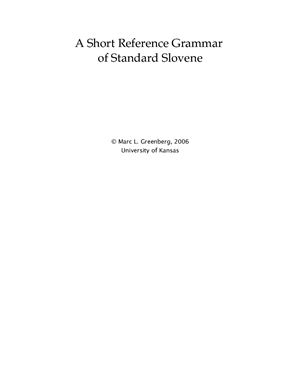Publisher: University of Kansas
Publication date: 2006
Number of pages: 189
This is a very good slovene Grammar from the Slavic and East European Language Research Center of Duke University.
This grammar is meant to be a brief reference for the main grammar points of contemporary standard Slovene, with some notes on salient differences between written and spoken usage, and, as such, it can hardly substitute for much more comprehensive works such as Herrity 2000, intended for readers of English, or Topori?i? 2000, intended for native Slovene users, nor the numerous handbooks and studies on specific areas of grammar at which the References section below can only hint.1 Nevertheless, this grammar attempts to innovate over most or all handbooks on Slovene grammar in at least few ways, e.g., it offers as many contextual examples from real texts as practible, in the belief that concise statements about usage generally fail to capture the subtleties and robustness of actual usage—context-rich examples partially fill this gap; information about the tonemic accent properties of words are represented in a manner that is more efficient than in traditional Slovene grammars; an attempt has been made to capture at least some salient characteristics of the relationship between standard and substandard codes, especially the spoken language of Ljubljana and its environs. Certain topics —such as the accentuation of nouns in the tonemic pronunciation variant, word-formation, or a complete overview of discourse markers—are so complex that anything approaching a comprehensive survey would so thicken the exposition that it could no longer be considered a brief reference.
Publication date: 2006
Number of pages: 189
This is a very good slovene Grammar from the Slavic and East European Language Research Center of Duke University.
This grammar is meant to be a brief reference for the main grammar points of contemporary standard Slovene, with some notes on salient differences between written and spoken usage, and, as such, it can hardly substitute for much more comprehensive works such as Herrity 2000, intended for readers of English, or Topori?i? 2000, intended for native Slovene users, nor the numerous handbooks and studies on specific areas of grammar at which the References section below can only hint.1 Nevertheless, this grammar attempts to innovate over most or all handbooks on Slovene grammar in at least few ways, e.g., it offers as many contextual examples from real texts as practible, in the belief that concise statements about usage generally fail to capture the subtleties and robustness of actual usage—context-rich examples partially fill this gap; information about the tonemic accent properties of words are represented in a manner that is more efficient than in traditional Slovene grammars; an attempt has been made to capture at least some salient characteristics of the relationship between standard and substandard codes, especially the spoken language of Ljubljana and its environs. Certain topics —such as the accentuation of nouns in the tonemic pronunciation variant, word-formation, or a complete overview of discourse markers—are so complex that anything approaching a comprehensive survey would so thicken the exposition that it could no longer be considered a brief reference.

